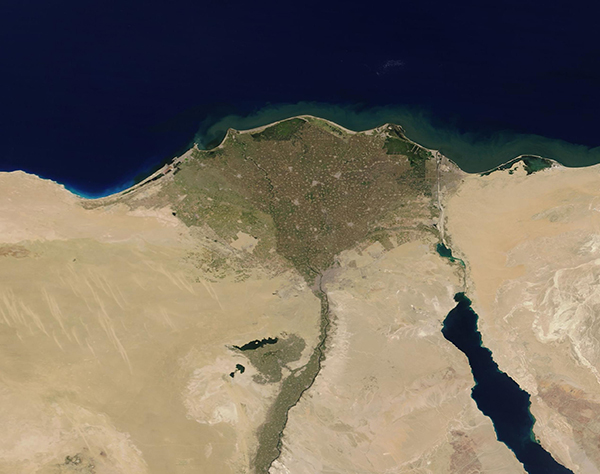Images
May 26, 2021 - Nile River Delta
Tweet
This stunning true-color image of the Nile River Delta, Egypt on a sunny late-spring day was acquired by the Moderate Resolution Imaging Spectroradiometer (MODIS) on board NASA’s Terra satellite. The expansive green delta of the Nile River blooms like a flower in the desert and is formed from the wide floodplain created as the Nile splits into the Rosetta (west) and Damietta (east) branches. By the time these branches reach the Mediterranean Sea, they sit roughly 87 miles (140 km) apart. The Delta spans roughly 10,039 square miles (26,000 square km).
Before the construction of the Aswan High Dam, which opened in 1970, the Nile River braided into many channels as it widened near the Egyptian city of Cairo. Flood waters would carry nutrient-rich sediment from the upper reaches of the river to the Delta where the sediment would be deposited across the entire flood plain. Today flow levels have been greatly reduced, even in flood season, and all that remains of the braids are several lakes.
Despite the reduced flow, the Nile Delta remains extremely important for agriculture, fishing, habitat for wildlife, and is one of the world’s most important routes for migrating birds. It is also the most densely populated region of Egypt, with more than 39 million people calling the Delta home. In this image, vegetation appears green and arid desert looks tan. Light tan or gray smudges are the mark of human habitation, including the large city of Cairo located at the base of the Delta.
Image Facts
Satellite:
Terra
Date Acquired: 5/24/2021
Resolutions:
1km (209.4 KB), 500m (543.5 KB), 250m (286.5 KB)
Bands Used: 1,4,3
Image Credit:
MO'DIS Land Rapid Response Team, NASA GSFC
Tweet
This stunning true-color image of the Nile River Delta, Egypt on a sunny late-spring day was acquired by the Moderate Resolution Imaging Spectroradiometer (MODIS) on board NASA’s Terra satellite. The expansive green delta of the Nile River blooms like a flower in the desert and is formed from the wide floodplain created as the Nile splits into the Rosetta (west) and Damietta (east) branches. By the time these branches reach the Mediterranean Sea, they sit roughly 87 miles (140 km) apart. The Delta spans roughly 10,039 square miles (26,000 square km).
Before the construction of the Aswan High Dam, which opened in 1970, the Nile River braided into many channels as it widened near the Egyptian city of Cairo. Flood waters would carry nutrient-rich sediment from the upper reaches of the river to the Delta where the sediment would be deposited across the entire flood plain. Today flow levels have been greatly reduced, even in flood season, and all that remains of the braids are several lakes.
Despite the reduced flow, the Nile Delta remains extremely important for agriculture, fishing, habitat for wildlife, and is one of the world’s most important routes for migrating birds. It is also the most densely populated region of Egypt, with more than 39 million people calling the Delta home. In this image, vegetation appears green and arid desert looks tan. Light tan or gray smudges are the mark of human habitation, including the large city of Cairo located at the base of the Delta.
Image Facts
Satellite:
Terra
Date Acquired: 5/24/2021
Resolutions:
1km (209.4 KB), 500m (543.5 KB), 250m (286.5 KB)
Bands Used: 1,4,3
Image Credit:
MO'DIS Land Rapid Response Team, NASA GSFC




